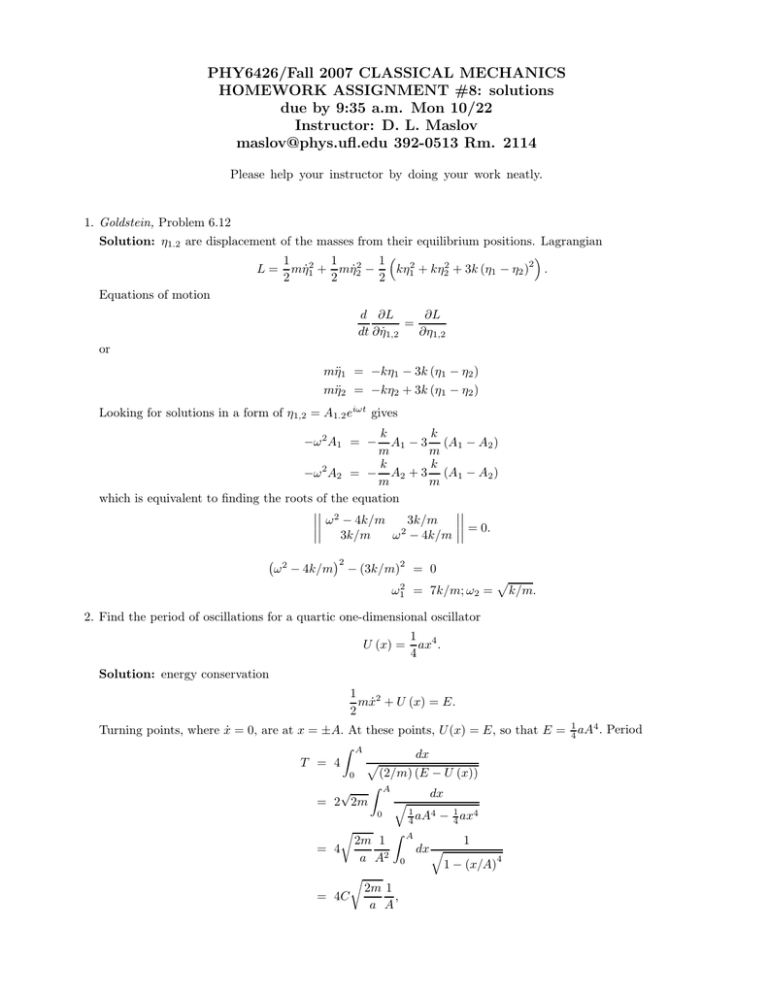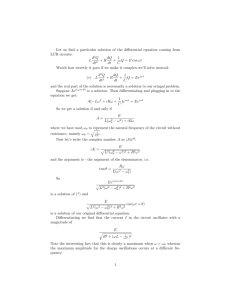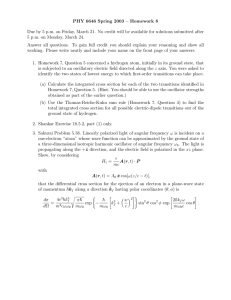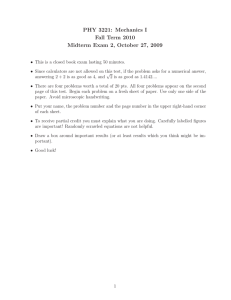PHY6426/Fall 2007 CLASSICAL MECHANICS HOMEWORK ASSIGNMENT #8: solutions Instructor: D. L. Maslov
advertisement

PHY6426/Fall 2007 CLASSICAL MECHANICS HOMEWORK ASSIGNMENT #8: solutions due by 9:35 a.m. Mon 10/22 Instructor: D. L. Maslov maslov@phys.ufl.edu 392-0513 Rm. 2114 Please help your instructor by doing your work neatly. 1. Goldstein, Problem 6.12 Solution: η1.2 are displacement of the masses from their equilibrium positions. Lagrangian 1 1 1 2 2 L = mη̇12 + mη̇22 − kη1 + kη22 + 3k (η1 − η2 ) . 2 2 2 Equations of motion ∂L d ∂L = dt ∂ η̇1,2 ∂η1,2 or mη̈1 = −kη1 − 3k (η1 − η2 ) mη̈2 = −kη2 + 3k (η1 − η2 ) Looking for solutions in a form of η1,2 = A1.2 eiωt gives k k A1 − 3 (A1 − A2 ) m m k k −ω 2 A2 = − A2 + 3 (A1 − A2 ) m m which is equivalent to finding the roots of the equation 2 ω − 4k/m 3k/m = 0. 3k/m ω 2 − 4k/m −ω 2 A1 = − ω 2 − 4k/m 2 − (3k/m)2 = 0 ω12 = 7k/m; ω2 = 2. Find the period of oscillations for a quartic one-dimensional oscillator U (x) = p k/m. 1 4 ax . 4 Solution: energy conservation 1 mẋ2 + U (x) = E. 2 Turning points, where ẋ = 0, are at x = ±A. At these points, U (x) = E, so that E = 41 aA4 . Period Z A dx p T = 4 (2/m) (E − U (x)) 0 Z A √ dx q = 2 2m 1 1 4 4 0 4 aA − 4 ax r Z A 2m 1 1 = 4 dx q a A2 0 4 1 − (x/A) r 2m 1 = 4C , a A 2 where C= Z 1 0 dy p 1 1 − y4 = 1 B 4 1 1 , 4 2 ≈ 1.31 . . . with B (x, y) = Γ (x) Γ (y) /Γ (x + y) being a beta-function. Finally, r m1 T = 7.42 . a A Note that the period decreases with increasing amplitude. 3. Using the perturbation theory, find the eigenfrequencies and eigenmodes of a one-dimensional oscillator with potential energy U (x) = 1 2 1 4 kx + ax 2 4 in the limit a → 0. Which dimensionless parameter controls the convergence of the perturbation theory? Solution: Equation of motion mẍ = −kx − ax3 or ẍ + ω02 x = −αx3 → ω02 ω02 2 3 ẍ + ω0 x = −αx − 1 − 2 ẍ ω2 ω where ω02 = k/m and α = a/m. Seek for a solution in a form x = A cos ωt + x1 . . . ω = ω0 + ω1 + . . . To leading order in α, this gives ẍ1 + ω02 x1 = −αA3 cos3 ωt + 2ω0 ω1 A cos ωt. Transform cos3 ωt as 1 cos3 ωt = cos ωt cos2 ωt = cos ωt (1 + cos 2ωt) 2 1 1 1 1 = cos ωt + cos ωt cos 2ωt = cos ωt + (cos ωt + cos 3ωt) 2 2 2 4 3 1 = cos ωt + cos 3ωt. 4 4 The eq-n of motion now take the form 3 1 ẍ1 + ω02 x1 = − αA3 cos ωt − αA3 cos ωt + 2ω0 ω1 A cos ωt. 4 4 The term oscillating with frequency ω in the RHS looks like a force almost at resonance with the original frequency. This resonance is unphysical as our anharmonic oscillator is an isolated system. To avoid the resonance, we require that the coefficient of the cos ωt term vanishes. This gives ω1 = 3 A2 α . 8 ω0 Finally, the equation for x1 reduces to ẍ1 + ω02 x1 = − αA3 cos 3ωt. 4 3 The solution is x1 = − αA3 cos 3ωt. 32ω02 Collecting everything together, the lowest order solution is αA3 cos 3ωt 32ω02 3 A2 3 A2 = ω0 1 + α 2 . ω = ω0 + α 8 ω0 8 ω0 x = A cos ωt + The dimensionless parameter controlling the convergence of the perturbative expansion is 3 A2 8 α ω02 .






